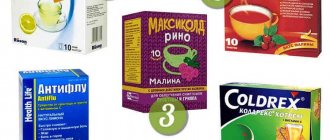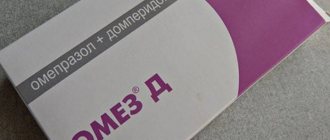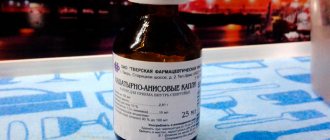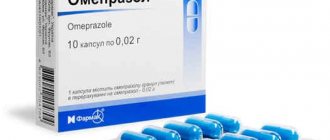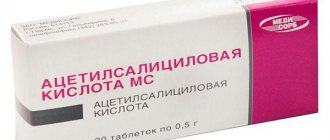Release form and composition
The product is based on a substance that affects the synthesis of hydrochloric acid - omeprazole. The main effect is to restore the processes of juice secretion, reduce acidity, and prevent negative effects on the stomach receptors from the outside.
Another active component - domperidone - is aimed at increasing the tone of the lower gastrointestinal sphincter, normalizing the process of bowel movements and restoring intestinal motility. The drug is available in 3 forms - capsules, powders for suspensions and infusions. Based on this, they have different auxiliary components.
Capsules
There are 3 types, depending on the content of the active substance omeprazole - 10, 20, 40 mg. They are also divided into types based on the capsule shell:
- the usual coating consists of hypromellose 6 cps;
- enteric coating - sodium hydroxide, methacrylic acid, macrogol 6000, methyl methacrylate copolymer, titanium dioxide, talc;
- gelatin capsules: gelatin, E122 (azorubine coloring), methyl parahydroxybenzoate, water, propyl parahydroxybenzoate.
Auxiliary components of internal filling:
- sodium hydrogen phosphate;
- mannitol;
- sodium lauryl sulfate;
- sucrose;
- lactose;
- hypromellose 6 cps.
Inside the capsules there are white granules, the body is colorless, the cap is pink or purple. Each part of the capsule is marked in black with the name of the drug in English (OMEZ). Capsule tablets are packaged in aluminum strips of 10 units. One cardboard package may contain 1 or 3 blisters, 10 and 30 capsules, respectively.
Insta powder
Purpose: preparation of a suspension for oral administration (orally). The powdery mixture has a white color, a mint smell, and is packaged in bags of 5, 10, 20, 30 pieces per package. The content of the active substance omeprazole is 20 mg. Additional Ingredients:
- sodium bicarbonate;
- mint flavor;
- sucrose;
- xylitol;
- gum.
Before consumption, the powder is diluted with purified water.
Powder lyophilisate
Purpose: preparation of an infusion solution for intravenous drip administration. It is produced in the form of a powder, packaged in colorless glass bottles, and packaged in cardboard boxes. The content of the active substance is 40 mg. Auxiliary components:
- sodium hydroxide;
- edetate disodium.
Before use, add a 5% glucose (dextrose) solution to the contents of the bottle (the drug should not contain preservatives).
pharmachologic effect
The main effect of the drug Omez is associated with the inhibition of hydrochloric acid. If the drug is taken daily, the secretion of glands in the stomach decreases for a long period of time. This can lead to the formation of benign glandular cysts, which subsequently resolve on their own. Due to a decrease in the concentration of hydrochloric acid in the blood serum, the amount of gastrin and chromogranin A increases, therefore it is prohibited to take the drug during malignant processes.
Pharmacodynamics
The active substance is localized in the secretory tubules of parietal cells on the gastric mucosa, that is, in an acidic environment, against which the activation and inhibition of the proton pump (H+/K+-ATPase enzyme) occurs. The mechanism of action has its own characteristics:
- Omeprazole affects the synthesis of hydrochloric acid in a dose-dependent manner, therefore, basal and stimulated acid secretion is inhibited, regardless of the stimulus factor.
- The substance affects the production of gastric juice, which leads to rapid inhibition of daytime and nighttime hydrochloric acid.
- If you take the dosage form at a dosage of 20 mg, then throughout the day the acidity level decreases by 80-90%, and the concentration of hydrochloric acid - by 60-70%.
- The rate of action of drugs most often depends on the level of concentration of the active substance in the blood plasma. When taking Omez, the inhibition process is based on the pharmacokinetic AUC curve, that is, concentration and time.
- Omeprazole additionally has bactericidal properties against the bacterium Helicobacter pylori, especially when taken simultaneously with antibiotics.
- The drug promotes the regeneration of damaged cells and tissues of the mucous membranes of the gastrointestinal tract, therefore it is actively prescribed for ulcerative lesions.
Pharmacokinetics
The active substance is absorbed quickly - maximum plasma concentration is reached after 60-120 minutes. The absorption process is noted in the small intestine, the completion time is from 3 to 6 hours. The bioavailability of the drug is 40% with a single dose. If you drink the capsules/powder a second time, the level of bioavailability increases. However, food intake does not affect this in any way. Omeprazole binds to plasma proteins by 90-97% and is quickly distributed throughout the body.
Features of metabolism and excretion from the body:
- The substance is metabolized via systemic cytochrome P450 in the liver.
- During metabolism, inactive metabolites are formed.
- The expressed CYP2C19, which is responsible for the synthesis of hydroxyomethprazole (the main metabolite), completely affects metabolism.
- The effect of CYP3A4 is also important (a specific isoform forms the omeprazole sulfone).
- The active substance does not inhibit CYP enzymes.
- The half-life is approximately 40 minutes (in case of liver failure, the time increases to 3 hours).
- Blood plasma clearance is 0.3-0.6 l/min.
- The substance is excreted 70% through urinary fluid, 30% through feces from bile secretion.
- When taken once a day, the drug does not accumulate in the blood.
- When taken twice, the AUC of the substance increases, but the concentration level depends on the dosage of the drug. This suggests a nonlinear relationship between time and dose. The reason for this is a decrease in presystemic metabolism and clearance due to suppression of the CYP2C19 enzyme.
- Omeprazole AUC may increase due to liver disease as metabolism changes.
- With dysfunctional abnormalities in the renal system, the rate of metabolism and excretion from the body does not change.
- The metabolism of active substances slows down in old age, starting from 75 years of age.
special instructions
Stomach problems
Before starting therapy with Omez, the patient must exclude the possibility of the presence of any malignant processes in the body (this is especially true for patients suffering from stomach ulcers). This is explained by the fact that treatment with Omez can mask the symptoms of cancer, as well as delay the correct diagnosis by a doctor.
Taking the drug with food does not in any way affect its effectiveness.
Indications for use of Omez
Since the drug is based on suppressing the secretion of hydrochloric acid, Omez has a wide range of applications:
- duodenal and gastric ulcers;
- erosion;
- gastritis with high acidity;
- damaged esophagus in the lower part;
- gastroesophageal reflux disease;
- esophagitis reflux;
- gastrinoma;
- heartburn;
- infection of the mucous membranes of the stomach and intestines;
- Zollinger-Ellison syndrome;
- pancreatitis;
- mastocytosis;
- long-term use of non-steroidal anti-inflammatory drugs, against the background of which the mucous membranes of the gastrointestinal organs are damaged.
Quite often, Omez is prescribed a couple of hours before surgery, thereby preventing the risk of acidic gastric juice entering the respiratory system.
Overdose
Confusion during an overdose of Omez.
In case of an overdose, the following suspicious symptoms may occur:
- confusion;
- drowsiness, decreased performance;
- headache and dizziness;
- rapid heartbeat and arrhythmia;
- nausea, vomiting;
- dry mouth;
- blurred vision.
In case of overdose, you should contact an ambulance.
Methods of taking Omez
Omez is prescribed for various diseases. In each individual case, there is a specific method of using the drug.
Capsules:
- For reflux esophagitis, take 20 mg once a day (1 capsule of the appropriate dosage of the active substance). The course of admission is six months.
- Acute stomach ulcer: 1 or 2 capsules per day (no more than 40 mg) for 1-2 months, depending on the degree of damage and advanced stage of the disease.
- Duodenal ulcer during exacerbation: once a day, 20 mg. The duration of treatment varies from 14 to 30 days. In particularly advanced cases, the daily dose increases to 40 mg.
- For infection with Helicobacter pylori: the daily dose is 40 mg, divided into 2 doses. The course of therapy is a week. It is mandatory to take antibacterial medications.
- Erosion, use of non-steroids, damage to the mucous membranes of the gastrointestinal tract: 20 mg per day for one or two months.
- For Zollinger-Ellison syndrome, the minimum dosage is 60 mg. Depending on the acidity level, the norm can be increased to 120 mg. Number of doses: twice a day.
Capsules are washed down with water and taken at any time of the day, regardless of meals.
Infusion solution:
- The solution is administered intravenously.
- The dosage depends on the level of damage.
- The minimum norm is 40 mg. The drug is administered once a day.
- The maximum dose is 60-80 mg. Administration is carried out twice a day.
- The duration of the course of treatment depends on the speed of elimination of unpleasant symptoms, after which capsules or suspensions are prescribed.
Powder for suspensions:
- pour 1 sachet of powder into a glass;
- add 2 tbsp. l. clean water;
- to stir thoroughly;
- drink half an hour before meals;
- daily dosage - 20-40 mg.
Omez for gastritis
Gastritis is divided into 2 main forms - with low and high acidity. Since Omez reduces the level of acid in the gastrointestinal tract, it is prohibited to take it with low acidity, as this will further aggravate the patient’s condition. But with increased acidity, the drug, on the contrary, is recommended for use. With this form of gastritis, frequent heartburn, belching, nausea, bloating, and aching pain are noted. All these signs appear due to the release of hydrochloric acid, which affects the mucous membranes. When taking Omez, acidity is significantly reduced, an alkaline (favorable) environment is formed, which relieves pain, eliminates belching and heartburn, and restores digestion.
There is also an atrophic type of gastritis, in which the walls of the mucous membranes of the stomach atrophy. Omez regenerates (heals) damaged epithelium.
Rules for taking capsules and powder for suspensions:
- The daily dose of the drug is 20 mg.
- The duration of the course is from 10 to 15 days.
- For reflux gastritis, the duration of treatment is 30-60 days.
- In case of severe pain and in the acute phase, the dosage is increased to 40 mg.
- For chronic gastritis, therapy lasts 3-4 months.
An infusion solution is administered if it is impossible to relieve symptoms using capsules.
Omez for heartburn
Heartburn is a symptom of many diseases of the gastrointestinal tract, in which the acidity of gastric juice increases. Omez is indicated for use precisely in such cases. If heartburn occurs due to the consumption of certain foods, then it is not advisable to take the drug, since the etiology of the symptom remains unknown. An infusion solution is not used to combat heartburn, only a capsule form and suspension.
Features of application:
- If heartburn occurs occasionally, it is enough to take the drug 10-20 mg.
- If the symptom persists, the dosage ranges from 40 to 120 mg, based on the severity of the underlying disease.
- The minimum duration of therapy is 4 days, the maximum is 2 weeks.
- It is advisable to take the medicine 3-4 hours before bedtime, before dinner.
Omez for pancreatitis
With pancreatitis, enzymatic substances produced by the body are activated in the pancreas, and not in the duodenum, as in a healthy person. This promotes tissue destruction, against the background of which cells affected by toxins penetrate into the bloodstream, which leads to dysfunction of the cardiovascular system, lungs, and kidneys. In addition, the main complication of pancreatitis is gastroesophageal reflux disease. Omez helps reduce the load on the pancreas by inhibiting the process of activation of enzymes that cause pancreatitis. The drug suppresses acidity, reduces intrapancreatic pressure, and therefore relieves pain.
How to take capsules and suspension for pancreatitis:
- in the first one and a half to two months, drink 20 mg twice a day;
- Omez is subsequently used as maintenance therapy, 1 capsule per day (20 mg).
Should I take the drug before or after meals?
"Omez" is taken before meals or immediately during. Before prescribing the drug, the doctor collects an anamnesis, including the height, weight and age of the child, as well as the presence of contraindications and the course of the disease.
If the child weighs less than 10 kilograms, the daily dosage for him will be 5 mg. If your weight is more than 10 but less than 20 kilograms – 10 mg. For a child whose weight is more than 20 kilograms, a dosage of 20 mg per day is prescribed. This is confirmed by the instructions for Omez for children.
Contraindications for Omez
When is it prohibited to use Omez:
- oncological neoplasms in the gastrointestinal tract (the active substance promotes tumor growth);
- calcium deficiency (omeprazole releases this trace element from the body);
- infection with salmonella or campylobacter (the active substance creates a favorable environment for these bacteria);
- liver failure (in this case the metabolism of the drug slows down);
- age up to 2 years (capsules, suspension);
- age up to 18 years (intravenous administration);
- individual intolerance to components (allergy);
- reduced acidity of gastric juice;
- intestinal obstruction;
- internal bleeding;
- period of pregnancy and breastfeeding;
- simultaneous use of certain groups of drugs.
Instructions
When a doctor prescribes Omez to a child, he must describe the dosage regimen in detail, since there is no such information in the instructions supplied with the drug. If a child is over two years old and weighs more than 20 kilograms, then the standard daily dosage of omeprazole will be 20 mg or one capsule. It is not recommended to give the drug to a child for more than two months.
If the child is over four years old, the daily dosage of omeprazole will be similar to the previous option, but combination with other drugs is also allowed.
It is not recommended to drink Omez with anything other than water, as other liquids can significantly reduce the effectiveness of omeprazole. It is best to warm the water a little, so the activation of the active ingredient will occur as efficiently and quickly as possible.
If we talk about capsules, then such treatment is prescribed to children in accordance with their ability to swallow the drug whole. The membrane must not be damaged, since in this case omeprazole will be activated earlier and will not have an effect where it is needed.
Side effects of Omez
Negative reactions occur against the background of uncontrolled use of Omez, in the presence of contraindications. What can happen:
- Immune system: sometimes angioedema, fever, anaphylactic shock (against the background of an allergic reaction) occur.
- Endocrine system: hypocalcemia, hypomagnesemia, hypokalemia, hyponatremia (deficiency of these substances, as they are excreted from the body in large quantities) are occasionally observed.
- Psyche: depression, insomnia, confusion, excitability. Very rarely, hallucinations begin and aggressiveness appears.
- Nervous system: headache, dizziness, increased drowsiness, impaired taste.
- Visual apparatus: decreased visual acuity, temporary loss of clarity of vision.
- Labyrinthine reactions, auditory organs: ringing in the ears, sensation of objects or body spinning, poor hearing.
- Respiratory system: bronchospasm.
- Gastrointestinal organs: rarely - colitis, stomatitis, dry mouth, change in the shade of the tongue. Very rarely - cyst formation, gastrointestinal candidiasis. Quite often - pain, diarrhea or constipation, nausea and vomiting, flatulence.
- Liver, biliary tract: jaundice, hepatitis, liver failure.
- Skin: rashes, itching, burning, dermatitis, urticaria, hyperemia (redness). Extremely rare: toxic necrolysis of the epidermis, severe erythema (Stevens-Johnson disease).
- Connective tissues, musculoskeletal: myalgia, arthralgia, muscle weakness, fractures due to osteoporosis.
- Kidneys: interstitial nephritis.
- With intravenous administration, swelling may occur at the puncture site. Sometimes sweating increases and weakness appears.
To avoid adverse reactions, be sure to consult a doctor, do not self-medicate and strictly adhere to the dosages prescribed by the gastroenterologist.
Side effects when taking the drug
The medication has a fairly impressive list of unpleasant side effects that are possible after administration orally or intravenously. They happen extremely rarely and disappear immediately after stopping use.
Most often, allergic manifestations were noticed in the form of a rash or urticaria. Omez is allowed to be purchased at a pharmacy without a specialist prescription.
The instructions list the following side effects:
- Problems with stool. Everyone may experience unpleasant symptoms differently. The drug can cause severe diarrhea and encourage frequent bowel movements. It can also cause a complete lack of stool and constipation;
- Painful sensations, bloating, heaviness in the abdomen;
- Severe nausea, rarely vomiting;
- Flatulence, severe gas formation;
- Liver disorders;
- Changed taste in the food the patient eats;
- Liver functions are impaired. In some cases, icteric hepatitis is possible;
- Stomatitis;
- Dry mouth;
- Disturbances in the composition of the blood. Rarely – leukemia;
- People exposed to severe emotional stress and with a weak nervous system may be susceptible to mental health problems. There is a possibility of depression, excessive excitability, aggressiveness, nervousness, breakdowns;
- Patients with a diseased liver are susceptible to hepatic encephalopathy;
- General weakness of the body, malaise;
- Deterioration of vision;
- Hair loss;
- Allergic reactions. Severe itching, redness on the skin and other manifestations of allergies;
- Possible swelling of the body;
- Increased sweating;
- Cysts in the stomach.
These side effects occur extremely rarely. If they appear, you should consult a doctor and change this medicine to another.
If undesirable effects are minor, they may be alleviated and symptoms may be relieved. The doctor may reduce the dosage or replace it with similar medications.
In case of allergic reactions to the products, you must immediately stop taking the capsules.
Interaction
Omez does not interact with all dosage forms, so you should consult a doctor before consuming it. You need to pay attention to the following facts:
- Products based on substances with pH-dependent absorption, as the level of absorption of beneficial substances decreases. These are the active ingredients: itraconazole, ketoconazole, cyanocobalamin, iron, erlotinib, posaconazole.
- When taking Omez and Digoxin simultaneously, the bioavailability of the latter drug increases, which will require adjustment of the daily dosage.
- When using Clopidogrel, there is a decrease in the level of inhibition of platelet aggregation and a decrease in exposure to clopidogrel metabolites.
- Antiretroviral drugs. Omeprazole increases the pH value, so these drugs are poorly absorbed by the body. In addition, the concentration of the active substances of the group decreases and the duration of action of omeprazole slows down. These are drugs such as Nelfinavir, Atazanavir, Saquinavir.
- Omeprazole increases the amount of the active substance of the drug Tacrolimus and Methotrexate, so adjustment of the dose taken is necessary.
- Drugs whose metabolism depends on the CYP2C19 isoenzyme: Hexobarbital, Warfarin, Diazepam, Disulfiram, Phenytoin, Imipramine, Cilostazol, Citalopram, Clomipramine. As in the previous case, the concentration of substances in the blood plasma increases significantly and the elimination time increases.
- Drugs with inhibitors of the isoenzyme CYP2C19, CYP3A4: Clarithromycin, Erythromycin, Variconazole. The metabolism of Omez slows down, the concentration of the active substance in the blood plasma increases.
- When taking Omez simultaneously and inducers of the CYP2C19 and CYP3A4 isoforms, metabolic processes are accelerated, increasing the amount of omeprazole. Preparations: Rifampicin, products based on St. John's wort.
- There is no interaction with the following medications: Diclofenac, Propranolol, Theophylline, Metronidazole, Amoxicillin, Quinidine, Lidocaine, Estradil.
Omez's analogs
Analogues are drugs that are similar in principle of action or composition. They may be cheaper or more expensive than the original. Their list is quite extensive. Therefore, before purchasing a similar product, you must carefully study all the pros and cons.
Which is better: Omez or Omeprazole?
Omeprazole has an identical composition in terms of the main active ingredient, and therefore has the same therapeutic effect. Which drug should you prefer? Difference:
- The analogue is produced by a Russian pharmaceutical company, so the cost of the product is several times lower.
- Excipients differ. Both drugs contain the following: mannitol, sucrose, sodium lauryl sulfate, hypromellose. Omez contains sodium hydrogen phosphate, Omeprazole contains calcium phosphate and carbonate, polyethylene glycol, titanium dioxide, and the protective shell contains many dyes and acetic acid. It follows from this that Omez is considered safer for the body.
- The readings are completely identical.
- The release form of Omez is wider; Omeprazole is produced only in capsules of 20 and 40 mg.
- Adverse reactions with the analogue occur more often.
Which is better: Omez or Nolpaza?
Both drugs have a similar effect - they reduce the level of hydrochloric acid concentration. They have the same indications and belong to the same group, but there are differences between them:
- The active substance of Nolpaza is pantoprazole sodium (a derivative of benzimidazole), Omeza is omeprazole. The first substance is considered more modern, and therefore highly effective.
- Nolpaza is of European quality, but Omez has proven itself on the positive side for decades.
- The cost of the analogue is much higher.
- Nolpaza is produced in Slovenia, Omez - in India.
- To achieve lasting positive dynamics, Omez is used longer than Nolpaza.
Which is better: Omez or Ranitidine?
The drug Ranitidine is based on ranitidine hydrochloride. The main effect is the suppression of histamine receptors in the mucous membranes of the stomach at the cellular level. Due to this, the concentration of hydrochloric acid decreases. Therefore, the indications for Ranitidine and Omez are the same. Both drugs have proven themselves on the positive side, but the difference between them lies in the mechanism of action (Rinitidine inhibits histamine receptors, and Omez inhibits enzymes that transfer protons to the part of the body where acid is synthesized). Omez has a higher cost, but has a smaller list of contraindications.
Which is better: Omez or De Nol?
The drugs are included in the same antacid group, but De Nol is also a sorbent that has gastroprotective and antibacterial properties. It contains an active substance - tripotassium bismuth dicitrate, and Omez - omeprazole. The analogue produces substances that create a protective film on the mucous membranes of the stomach, due to which hydrochloric acid is not released. Omez helps suppress the acidic environment.
De Nol is produced in the Netherlands, Omez - in India, so the first product has a price many times higher. Since the structural features of the drugs are different, they cannot be interchangeable. Therefore, it is advisable to use them together.
Which is better: Omez or Pariet?
The drugs have different compositions, but they share the same mechanism of action. Pariet is based on rabeprazole, which affects the body in the same way as omeprazole (the active substance of Omez). Pariet is considered a new generation drug, therefore its cost is almost 10 times higher.
Other features:
- Pariet has the highest degree of bioavailability, so it can be prescribed in particularly advanced cases.
- After taking Omez, adverse reactions occur more often.
- Pariet can be used by children starting from 12 years old, Omez - from 2 years old.
- Different release forms: Omez - capsules, powders, Pariet - tablets.
Which is better: Omez or Razo?
How do the drugs differ:
- Omez contains omeprazole, Razo is based on rabeprazole.
- The analogue is available exclusively in tablet form containing 20 mg of active substance. Omez is produced in the form of various capsules, powder for infusions and suspensions. The dosage of the active ingredient is 20 and 40 mg.
- Omez acts on the body longer than Razo, since the second remedy is a drug of a new generation.
- There is no withdrawal syndrome in Razo; in rare cases, Omez experiences acid hypersecretion.
- The analogue is several times more expensive than the original. This is especially true with a long course of treatment.
Which is better: Omez or Omizak?
The drugs are almost identical - the same active ingredient, a similar mechanism of influence on hydrochloric acid, due to which the microflora of the gastrointestinal tract is normalized. Accordingly, the indications for the drugs are identical. The cost does not differ significantly, but Omez has been known on the pharmaceutical market for much longer. Omizak appeared quite recently. For this reason, it is not very popular (people are wary of innovation).
If we talk about the release form, then Omez wins significantly. It can be purchased in different dosages - 10, 20, 30 mg, in the form of powder for intravenous administration, suspension and capsules. Omizak is produced only in capsule form, there is only one packaging - 50 units per package, while Omez can be taken from 10 pieces. The shelf life of the capsules varies - for Omez - 3 years, for Omizak - only 2.
Which is better: Omez or Losek Maps?
Both drugs are pump inhibitors and are included in the same group because they are based on the same active component - omeprazole. Accordingly, the mechanism of action is similar. Losek Maps is the original, and Omez is its analogue, because the first drug began to be produced much earlier. It is produced by Sweden, and Omez is produced by India, which is why the cost varies greatly. The price of the Swedish product is 4-5 times more expensive.
Losek Maps is produced in tablets, Omez - in powder for infusions and suspensions, capsules, which is why it is very popular. In terms of effectiveness and other criteria, the drugs are completely identical, but it is believed that the quality indicators of Losek are higher.
Which is better: Omez or Rabeprazole?
Medicines differ in their active component: Omez consists of omeprazole, Rabeprazole is based on the substance of the same name. However, both components have a similar mechanism of action - they suppress and protect the stomach from hydrochloric acid. The readings are slightly different. It is more advisable to use Omez when there is an increase in acidity while taking non-steroidal medications, as well as in case of ulcerative lesions. The reason for this is its regenerative properties. Rabeprazole is more suitable for the treatment of GERD, it is considered as safe as possible, therefore in some cases it is recommended during pregnancy.
Rabeprazole is produced in the form of capsules and tablets, so it can only be taken orally. Omez is also available in the form of an infusion powder, so it is administered intravenously. The active ingredient of the analogue is more expensive.
Which is better: Omez or Nexium?
The principle of action of the drugs is the same, but there are differences:
- Nexium consists of esomeprazole, Omez - omeprazole. The difference is as follows: esomeprazole is considered a modified formula from omeprazole, that is, improved (absorbed, distributed and excreted more evenly). Despite this, practice shows that the therapeutic benefits of the modification differ only slightly.
- Nexicum is produced by the Swedes, Omez is made in India, so the analogue is considered expensive.
- The Omez release form includes powder for intravenous infusion, capsules and powder for preparing a suspension, which is undoubtedly convenient. Nexium is available in oral granules and tablets.
Which is better: Omez or Ultop?
The medications are based on an identical active substance - omeprazole, so the principle of action is the same. The difference is this:
- Manufacturer Omeza - India, Ultopa - Slovenia. Accordingly, different price criteria. The first drug is cheaper.
- Ultop is available only in capsule form and as a solution for injections, Omez - in powder for injection and oral administration, capsules.
- Omez is considered safer, so in rare cases it can be prescribed during pregnancy (if the benefits outweigh the harm).
Which is better: Omez or Emanera?
Like Nexium, Emanera consists of esomeprazole and is therefore considered a new generation drug. The analogue has a smaller list of contraindications and adverse reactions, but the effectiveness is weaker than that of Omez. Based on this, Emanera is prescribed for mild gastrointestinal diseases. The price range is relatively the same.
How to protect yourself
The main rule is no uncontrolled self-medication and strict adherence to recommended dosages. It is important to carefully monitor the condition of the body during course therapy. If you feel unwell and have no other obvious causes, you should stop taking the drug and consult a doctor as soon as possible.
The stomach hurts, the heartbeat is felt at rest, headaches are tormented - any of these symptoms while taking Omez is a serious reason to visit a medical facility or call a specialist at home.
Before starting to take the medicine, it is necessary to exclude the presence of cancer localized in the digestive organs. A proton pump inhibitor masks the disease and prevents timely diagnosis and the choice of rational therapy.
With prolonged use in the intestine, the absorption of vitamin B12 is impaired, which can provoke the development of anemia. Therefore, it is necessary to include vitamin-mineral complexes rich in B vitamins in your diet.
Long-term courses of treatment require taking B vitamins
Particular caution is required when treating patients with osteoporosis and patients at risk. In this case, a doctor’s supervision and monitoring of test results are required. When taking any medication, the most important task of a specialist is to maintain a balance - prescribing the drug only if, in the ratio of benefit and harm, the first indicator sufficiently outweighs.
With long-term therapy, the concentration of magnesium in the body decreases. As a result, convulsions and heart rhythm disturbances occur. This problem can be solved by taking magnesium supplements.
If psychomotor reactions, vision and/or general well-being worsen, it is recommended to stop driving and other potentially dangerous activities.
If taking the medication causes a serious deterioration in your health, Omez substitutes are prescribed.
For children
A few years ago, Omez was prohibited for use by children under 12 years of age. Later, scientific research was carried out, thanks to which the drug in capsules and suspensions was allowed to be used from 2 years. Lyophilisate is prescribed from the age of 18. Feature - the child’s body weight should not be less than 20 kg.
Specifics of taking Omez:
- Starting from 2 years of age, the drug is prescribed for GERD (gastroesophageal reflux disease). The daily dosage per 1 kg of baby's weight ranges from 0.7 to 3.3 mg. On average, 20 mg of active substance per day is allowed. It is recommended to take the drug once for 1-2 months.
- At 4 years of age, Omez is prescribed for ulcerative lesions and the presence of Helicobacter pylori. The daily norm is 20-40 mg.
- Omez Insta is mixed with water or natural juice.
- It is difficult for a child to swallow the capsule, so it is opened, the granules are poured into a cup, and combined with an acidified component (juice, fruit puree).
- It is strictly prohibited to use dairy and fermented milk products, carbonated water and drinks as liquids.
Conditions and periods of storage of the medicine
This medication is approved for sale without presenting a prescription from a doctor to the pharmacist. It should be stored in a very dry, dark place and out of reach of children.
The recommended storage temperature is room temperature, not exceeding twenty-five degrees. The capsules will be stored for three years. Liquid for solutions and injections is stored for no more than two years.
It is not recommended to take the medicine after its expiration date. This can harm the body and lead to complications.
With alcohol
The components of Omez are inhibitors, and alcoholic beverages are ethanol-based catalysts. Alcohol substances participate in metabolism, releasing toxic products. When ethanol and toxic residues combine with the contents of Omez, a negative reaction occurs, as a result of which omeprazole ceases to inhibit hydrochloric acid. In simple terms, the effect of the drug is significantly reduced. In addition, CYP2C19 enzymes activate blocking metabolites, which increases the amount of toxic substances in the body, resulting in severe intoxication.
A person experiences the following symptoms:
- severe pain in the head;
- tremors in the arms and legs;
- nausea and vomiting;
- allergic reaction;
- hyperemia;
- nervous excitement;
- violation of movement coordination;
- diarrhea, constipation;
- bone pain;
- muscle aches;
- confusion.
Based on the above, we can conclude that alcohol is not compatible with Omez. If you have taken an alcohol-containing drink, then before drinking Omez, you must remove ethanol and its breakdown products from the body. This takes time: after drinking beer you need to wait from an hour to six, depending on the dose of alcohol taken. Wine is removed within 2 hours minimum, 17 hours maximum, vodka, cognac - 6-30 hours. You need to know that long-term use of the drug contributes to the accumulation of the active substance, so it is better to completely abstain from alcohol.
Reviews of "Omez" for children
Patients consider Omez one of the most effective drugs for treating the gastrointestinal tract, as well as for eliminating Helicobacter pylori. However, doctors do not recommend abusing the drug for any reason. It is advisable to take it in a course and only if there are regular manifestations of pathological processes in the gastrointestinal tract.
Doctors agree that Omez can be given to children, but only if there are serious indications. When prescribing a drug, a doctor is always guided by its safety for the child. In some cases, omeprazole becomes the only remedy that can effectively solve problems in the stomach or intestines.
Special attention of specialists when prescribing Omez to children is paid to its ability to flush calcium from the body. Pediatricians recommend strictly observing the duration of the course of taking the drug, without exceeding it, as this can lead to unpredictable consequences for the body. Most often, parents are satisfied with the treatment and its results, which confirms the effectiveness of the drug.
We found out whether children can take Omez.
Manufacturer
Omez is produced by Indian Pharmaceuticals. In Moscow there is a representative office of the organization at the address: Moscow, Ovchinnikovskaya embankment, 20/1, index 115035.
The drug Omez is considered safe for the gastrointestinal tract, but only in cases of increased acidity of gastric juice. Before use, you should undergo a comprehensive examination to determine the exact level of acidity. The dosage and duration of therapeutic measures depend on this.
Forms of the drug for children
Contrary to the recommendations of the instructions, many doctors prescribe Omez to children for the treatment of diseases of the stomach and intestines. The drug does not have a tablet form. Therefore, it is impossible to crush the medication and mix it with something sweet for oral administration. Taking capsules does not involve opening them and mixing them with other substances, which significantly complicates the use of the drug in children who do not yet know how to swallow the medication whole. To be more precise, opening the capsule is allowed, but the effectiveness of omeprazole in this case will significantly decrease. Doctors recommend mixing the contents of the capsule with baby applesauce.
According to the instructions for use for Omez, for children the best option for treatment is a medication in the form of a suspension. Parents note that the suspension has an unpleasant taste, and the single dosage is quite large, which makes it very difficult for the child to take the drug. In addition, when taking the suspension, many children experience a gag reflex. However, sometimes this may be the only possible drug option for treating gastrointestinal problems in children.
To prepare the suspension, you need to mix the contents of one sachet of powder with two tablespoons of water. The prepared suspension must be used immediately; it is not allowed to be stored, since omeprazole quickly loses its properties.
A powder for preparing a suspension called “Omez Insta” is produced. It is taken 30 minutes before meals. However, if the child complains of heartburn or other manifestations of gastrointestinal problems, the drug is taken as needed.
The instructions for the suspension are similar to “Omez” in capsules; the main difference between them is the prescribed dosage and indications for use. Independent use of omeprazole can lead to problems with the gastrointestinal tract. In general, children tolerate drug therapy well, which, as a rule, leads to complete recovery. Therefore, despite the existing contraindications, pediatricians widely use the drug in their practice.
We found out whether Omez can be prescribed to children.

